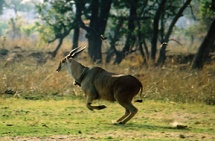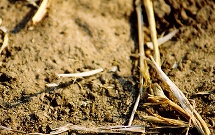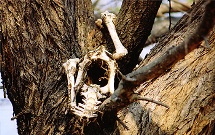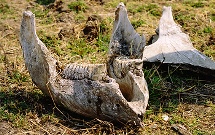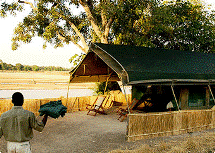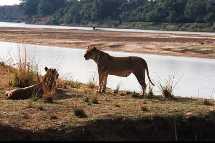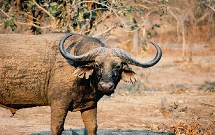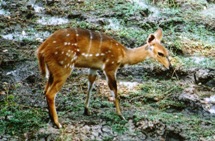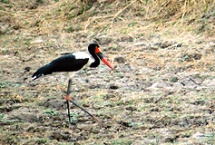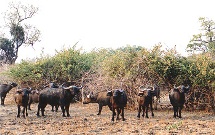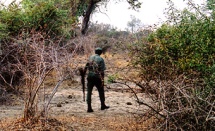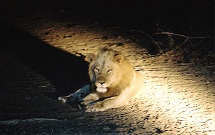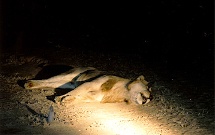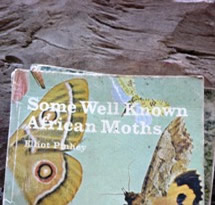Zambia (1): Day Four : Nsolo Bush Camp to Kakuli Bush Camp
This was to be quite a hard slog, since the distance from Nsolo to Kakuli was greater than from Luwi to Nsolo, and so we set off at the crack of dawn in order to avoid having to walk too far in the late morning heat. As we set off we could hear lion roaring in the direction that we were heading. Having discussed that we were still to sight a leopard, it was somewhat disconcerting to hear the periodic cough from our tea bearer at the rear of the file, said cough sounding exactly like the roar that a leopard makes (think of a coarse ripsaw tearing into a piece of softwood).
After half an hour or so an impala was seen racing along parallel to us. It ran for a good two hundred yards at top speed, leaping into the air (pronking) at intervals, obviously very full of the joys of morning. It finally came to a halt, totally winded, only to have to turn and race back the way it came as best it could, pursued by a pack of six wild dogs!
Shaddy reckoned that these were the same ones that we had seen the previous day (with the addition of one other). The impala appeared to have got clear, although with wild dog reported as having an 85% success rate on a hunt (unlike feline predators, they can just keep on running for hours) the eventual outcome was far from certain. The wild dog just have such an air of intelligent anticipation, and readily live up to their description as the ‘painted dog of Africa’. A truly marvellous sighting.
Plenty more game was to be seen on the walk, together with a stately eland ahead of us, and fortunately upwind. Normally eland are very shy creatures, and it is rare that they will allow you within about four hundred yards. However, with the aid of intervening bushes, and with the benefit of the wind, we were able to get within about thirty yards of this magnificent beast (![]() ), before it detected our presence and took off.
), before it detected our presence and took off.
Usually the guide will spot items of interest, game etc, long before we can, but on this occasion one of the guests – later nicknamed ‘Tracker Lloyd’ – was able to spot a straw-coloured praying mantis about an inch long, amongst the straw that littered our path (![]() ). Closer to Kakuli giraffe were seen, together with our first brief glimpse of (four) kudu. Fascinating, if somewhat gruesome, was an impala carcass left in a tree by a leopard (
). Closer to Kakuli giraffe were seen, together with our first brief glimpse of (four) kudu. Fascinating, if somewhat gruesome, was an impala carcass left in a tree by a leopard (![]() ). Near to the entrance of the camp itself was a four-year old elephant skull (
). Near to the entrance of the camp itself was a four-year old elephant skull (![]() ).
).
Welcomed into Kakuli (![]() ) at the end of a tough walk by Rachel McRobb and her partner Alec (the resident guide), together with scout Gideon. Several Malawi shandies were downed while we looked out over the plain in front of the camp at the two ‘resident’ ellies, Big Mike and Aristotle (don’t ask). Kakuli is a tented camp, situated on the bank of the Luangwa River itself, and hence for the first time we were able to take in the varied activities that occur along a riverine environment.
) at the end of a tough walk by Rachel McRobb and her partner Alec (the resident guide), together with scout Gideon. Several Malawi shandies were downed while we looked out over the plain in front of the camp at the two ‘resident’ ellies, Big Mike and Aristotle (don’t ask). Kakuli is a tented camp, situated on the bank of the Luangwa River itself, and hence for the first time we were able to take in the varied activities that occur along a riverine environment.
After such a long walk we were very happy to settle for an afternoon and evening game drive with Alec, and what a drive it turned out to be! Firstly we saw two lions on the banks of the river (![]() ). Their big bellies and the presence of a vulture nearby suggested that they had killed recently, but the bush was too thick to make it possible to locate the kill. Three suspicious kakuli (solitary old buffalo bulls) followed (
). Their big bellies and the presence of a vulture nearby suggested that they had killed recently, but the bush was too thick to make it possible to locate the kill. Three suspicious kakuli (solitary old buffalo bulls) followed (![]() ) together with a bushbuck (
) together with a bushbuck (![]() ), a saddle billed stork (
), a saddle billed stork (![]() ) a hammer kop and a banded mongoose. Then a fresh leopard kill (impala) was seen underneath a tree, although no trace could be seen of the actual leopard, and we moved on. Puku, more ellies and a huge herd of buffalo (over 600) followed (
) a hammer kop and a banded mongoose. Then a fresh leopard kill (impala) was seen underneath a tree, although no trace could be seen of the actual leopard, and we moved on. Puku, more ellies and a huge herd of buffalo (over 600) followed (![]() ). We then returned to the site of the earlier leopard kill, and Gideon stepped out of the vehicle and carefully explored the immediate bush (
). We then returned to the site of the earlier leopard kill, and Gideon stepped out of the vehicle and carefully explored the immediate bush (![]() ) to try to spot the leopard. Suddenly it dropped down from a small bush behind us and rapidly disappeared. Still, our first actual leopard sighting, by when it was time for sundowners.
) to try to spot the leopard. Suddenly it dropped down from a small bush behind us and rapidly disappeared. Still, our first actual leopard sighting, by when it was time for sundowners.
At this point it was discovered that, although the gin had been packed, and bottles of tonic in the chill box, the glasses had not. Obviously this made it difficult to pour out a gin & tonic (the sundowner of choice), but with a bit of lateral thinking we came up with the ‘bush gin & tonic’, created by drinking a part of the tonic water, followed by then filling up the bottle with gin (you don’t have to add the tonic to the gin – it can be the other way around!). A brief shake, and a squeeze of lemon, and the perfect accompaniment to another stunning sunset.
As we resumed the drive, quickly observing a white tailed mongoose, a superb lion was seen resting up just off our route, and was watched for several minutes. Next came two lions lying down a few yards apart, and we parked up in between them after photographing the nearer one (![]() ). As we were photographing the far one, which was lying out on its side, in the beam of the spotlight (
). As we were photographing the far one, which was lying out on its side, in the beam of the spotlight (![]() ), the one behind us let out a series of huge roars, causing a number of very inadequate torches to be shone fearfully to our rear – whereupon the other one began to answer the first one’s roars. Quite an exciting experience!
), the one behind us let out a series of huge roars, causing a number of very inadequate torches to be shone fearfully to our rear – whereupon the other one began to answer the first one’s roars. Quite an exciting experience!
Moving off we then spotted a civet (somewhat of an anticlimax) together with six more lions, who were obviously just beginning to think about going off on a hunt. On the way back into camp there were good sightings of giraffe, a genet, a further white tailed mongoose, a hyena and several civet. Then a beautiful lioness was seen walking down the road ahead, towards us, and we stopped to see what would happen. Regally she took absolutely no notice of us, merely deviating to pass by the side of the vehicle, close enough to touch, before letting out a loud roar and then moving off into the bush.
A final sight of the two river bank lions (above), now drinking from the river, and two honey badger on a banking near to the camp, followed by a pair of (male plus female) lions quite close to camp – only to be told that shortly before we arrived back, a pride of six lions had just walked straight through the camp, causing Rachel to hide behind the bar freezer. After yet another great meal we were escorted back to our tents (the elephants sometimes walk through just in front of them) and had no problem at all dropping off to sleep. What a day!
![]()
On one game drive we were explaining to a guest about Africa’s ‘LBJs’ (‘Little Brown Jobs’) – birds which, to our untutored eyes, look absolutely identical and unremarkable, their description providing you with an excellent impression of their appearance. Overhearing this, the guide pulled a two inch thick book out of his rucksack, entitled ‘LBJs of Southern Africa’.
However in my humble opinion, anybody who can identify and distinguish each of these must be regarded as somewhat sad, rather than knowledgeable. They need to get out more! Mind you, whoever wrote the book opposite - Some Well Known African Moths (![]() ) - must run him pretty close.
) - must run him pretty close.
| Back to previous page (Day 3) | Forward to next page (Day 5) |
